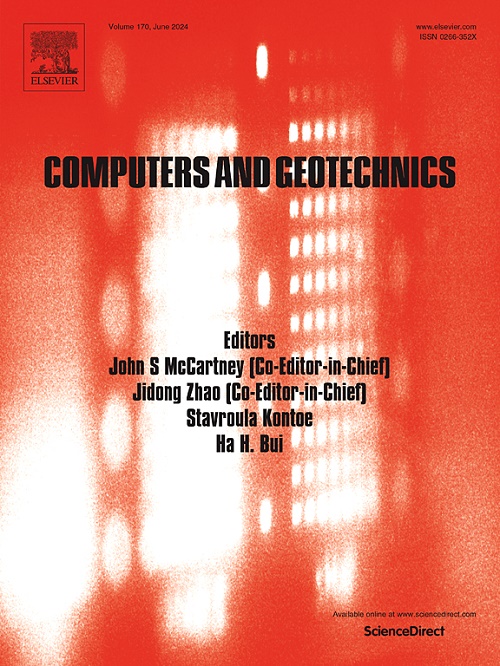冻结弱胶结节理岩体变形特征及断裂损伤模型
IF 6.2
1区 工程技术
Q1 COMPUTER SCIENCE, INTERDISCIPLINARY APPLICATIONS
引用次数: 0
摘要
在冻结状态下,以弱胶结和节理为特征的岩体表现出冰填充、冻胀加固和冻胀损伤的作用。因此,这些岩体的变形模量和断裂韧性受到冻结温度的影响,最终改变了结构面内裂缝的扩展过程。将未冻岩体视为由可压缩孔隙产生的软质物质和由岩石骨架构成的硬质物质组成的混合体,将冻结岩体的整个变形过程分为压实阶段和后压实阶段。对压实构件和骨架构件分别建立了本构关系方程。考虑低温环境对岩体力学特性的增强作用和冻胀损伤效应,提出了冻结负损伤、冻胀损伤和翼裂损伤变量的计算方法。在此基础上,建立了岩体骨架部分的宏细观损伤模型。通过冻结节理岩体的加载试验,验证了该模型的合理性。利用该模型探讨了冻结温度、岩体性质、节理倾角对岩体力学性质的影响规律。研究结果表明,冻结温度对岩体的压实阶段和弹性阶段均有显著影响,且随着冻结温度的降低,岩体的抗压强度相应增加。加载造成的总细观损伤随冻结温度的降低而减小,表明低温下岩体脆性增强。初始抗拉强度越高,岩体整体强度越高,翼裂损伤和冻胀损伤越小。节理倾角对冻结岩体力学特性的影响更为明显。本文章由计算机程序翻译,如有差异,请以英文原文为准。
Deformation characteristics and fracture damage model of freezing weakly cemented jointed rock masses
In the frozen state, rock masses characterized by weak cementation and nodular joints exhibit the effects of ice infill, frost-heave reinforcement, and frost-heave-induced damage. Consequently, the deformation modulus and fracture toughness of these rock masses are influenced by the frozen temperature, ultimately modifying the propagation process of fractures within structural planes. Considering the unfrozen rock mass as a composite consisting of soft material arising from compressible pores and hard material constituted by the rock skeleton, the entire deformation process of the frozen rock mass is categorized into a compaction stage and a post-compaction stage. Constitutive relationship equations are formulated separately for the compaction component and the skeletal component. Taking into account the reinforcing effect of low-temperature environments on the mechanical properties of rock mass, as well as the frost-heave damage effect, methods for calculating frozen negative damage, frost-heave damage, and wing crack damage variables have been developed. Based on these methodologies, a macro–micro damage model for the skeletal part of the rock mass has been established. The rationality of this model has been verified through loading tests on frozen jointed rock mass. Furthermore, the model has been employed to explore the influence rules of frozen temperature, rock mass properties, and joint inclination angles on the mechanical properties of rock mass. The research findings indicate that the freezing temperature significantly affects both the compaction and elastic phases of the rock mass, and the compressive strength increases correspondingly as the freezing temperature decreases. The total mesoscopic damage due to loading diminishes with decreasing frozen temperature, indicating that the rock mass becomes more brittle at lower temperatures. A higher initial tensile strength is associated with greater overall rock mass strength, accompanied by lesser wing crack damage and frost heave damage. The influence of joint inclination on the mechanical properties of frozen rock is more pronounced.
求助全文
通过发布文献求助,成功后即可免费获取论文全文。
去求助
来源期刊

Computers and Geotechnics
地学-地球科学综合
CiteScore
9.10
自引率
15.10%
发文量
438
审稿时长
45 days
期刊介绍:
The use of computers is firmly established in geotechnical engineering and continues to grow rapidly in both engineering practice and academe. The development of advanced numerical techniques and constitutive modeling, in conjunction with rapid developments in computer hardware, enables problems to be tackled that were unthinkable even a few years ago. Computers and Geotechnics provides an up-to-date reference for engineers and researchers engaged in computer aided analysis and research in geotechnical engineering. The journal is intended for an expeditious dissemination of advanced computer applications across a broad range of geotechnical topics. Contributions on advances in numerical algorithms, computer implementation of new constitutive models and probabilistic methods are especially encouraged.
 求助内容:
求助内容: 应助结果提醒方式:
应助结果提醒方式:


